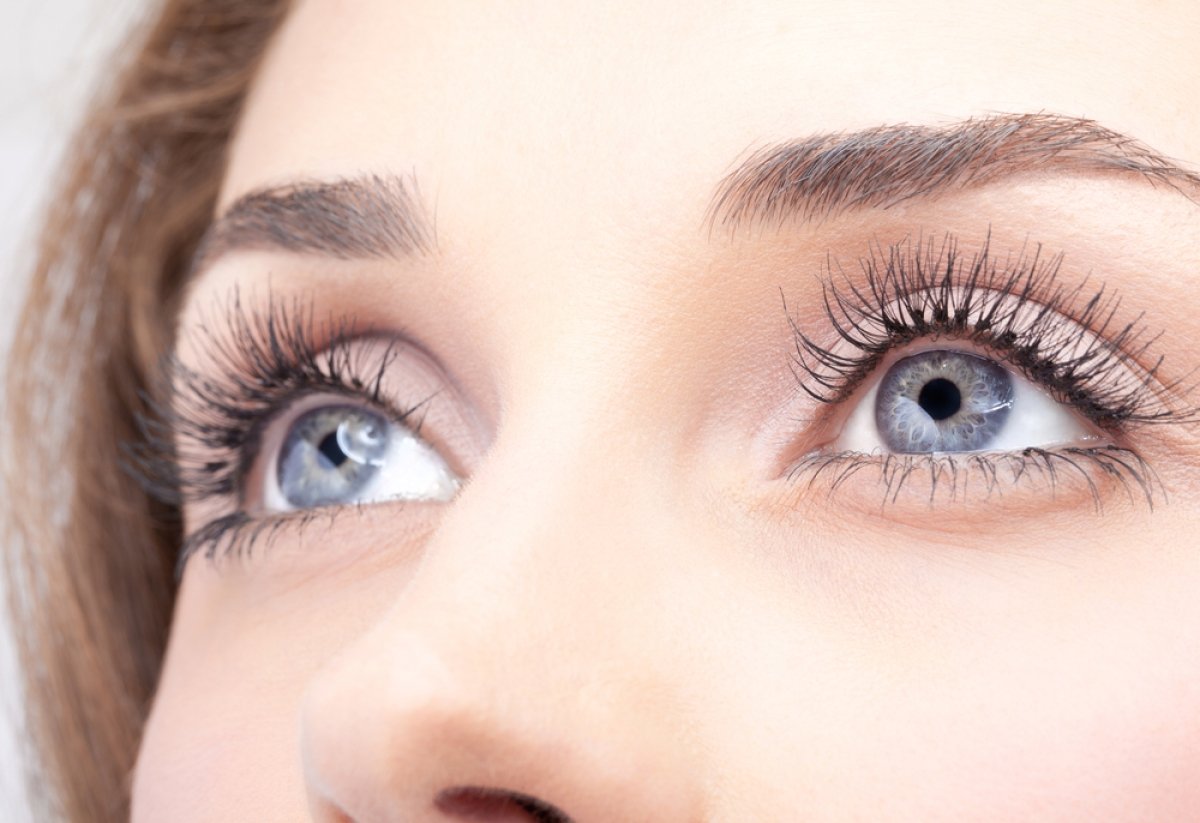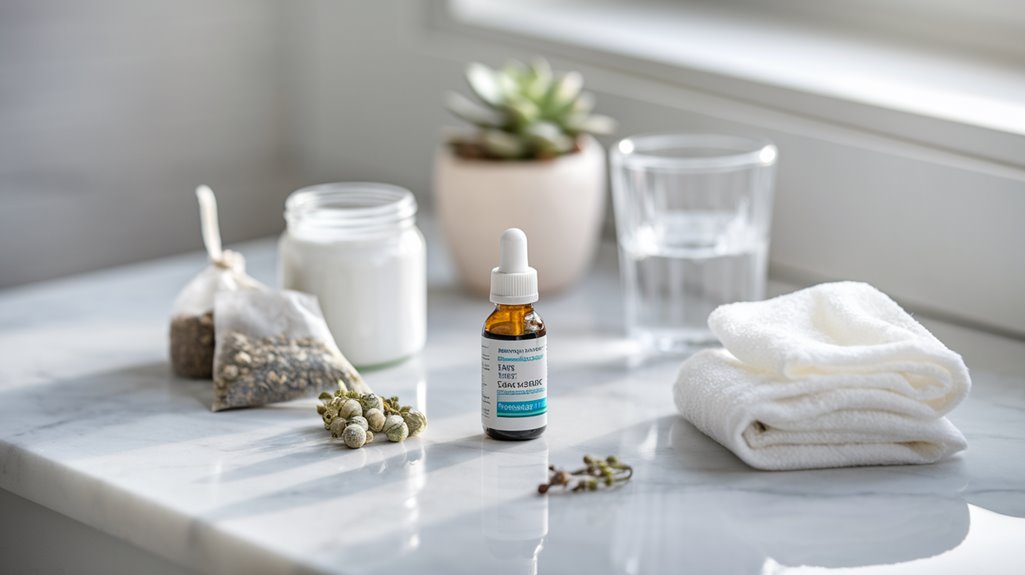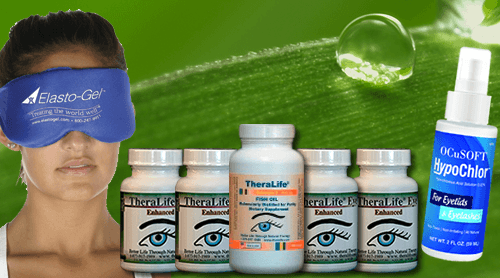To manage blepharitis, TheraLife offers a variety of products that benefit its customers by providing natural relief and promoting eye health. Their offerings include supplements designed to enhance tear production and reduce inflammation, addressing the root causes of blepharitis. TheraLife's approach integrates natural ingredients, which are beneficial in managing symptoms like dryness, irritation, and crustiness around the eyes. By focusing on holistic treatment, their products support overall eye wellness without the side effects associated with some medications. With a commitment to improving quality of life for those suffering from eye conditions, TheraLife provides effective solutions tailored to individual needs.
Key Takeaways
- Warm compresses and eyelid scrubs can alleviate blepharitis symptoms by improving meibomian gland function and reducing debris.
- Over-the-counter eyelid cleansing wipes effectively remove oil, crusts, and reduce bacterial load, aiding in symptom relief.
- Anti-dandruff shampoos with zinc pyrithione or selenium sulfide help normalize skin turnover and reduce eyelid inflammation.
- Prescription topical antibiotics and steroids manage severe inflammation and bacterial infections in blepharitis cases.
- Professional procedures like intense pulsed light therapy target inflammation and improve meibomian gland function for long-term relief.
Understanding the Causes of Blepharitis
Blepharitis, often caused by the dysfunction of the meibomian glands, results in inflammation along the eyelid margins. This condition can be triggered by several factors that interfere with normal gland function.
Bacterial colonization, particularly by Staphylococcus species, is a notable blepharitis trigger, disrupting the eyelid's natural defenses. Additionally, seborrheic dermatitis and rosacea can exacerbate glandular dysfunction, leading to inflammation.
The immune response plays a vital role in blepharitis, as the body's reaction to these triggers can result in chronic inflammation and irritation. Allergens and environmental stressors may also contribute, prompting an exaggerated immune response.
Understanding these causes is essential for effective management, as targeting specific triggers and modulating the immune response can considerably alleviate symptoms and improve patient outcomes. Regular eyelid hygiene is crucial to minimize symptom recurrence and manage blepharitis effectively.
Identifying the Symptoms of Blepharitis
How can you recognize the symptoms of blepharitis? Blepharitis symptoms often manifest as persistent eyelid irritation. You may notice redness, swelling, and crusting at the base of your eyelashes. This inflammatory condition can lead to itching, burning sensations, and a gritty feeling in your eyes. Distinguishing these symptoms is essential for early intervention.
Here's a concise comparison of common blepharitis symptoms:
| Symptom | Description |
|---|---|
| Eyelid Redness | Inflammation causing noticeable redness |
| Crusting | Build-up of debris around eyelashes |
| Itching | Persistent urge to scratch the eyelids |
| Burning Sensation | Sensation of heat or discomfort |
| Swelling | Puffiness around the eyelid margins |
Recognizing these symptoms helps you seek appropriate treatment. Understanding the clinical presentation of blepharitis aids in differentiating it from other ocular conditions. Additionally, meibomian gland dysfunction is often associated with posterior blepharitis, leading to issues with oil gland functionality.
Home Remedies for Blepharitis Relief
To alleviate blepharitis symptoms at home, you can start with warm compresses, which enhance meibomian gland function by loosening eyelid debris. Incorporating lid hygiene techniques, such as gentle eyelid scrubs, can reduce bacterial load and prevent exacerbations. Additionally, natural oil remedies, like tea tree oil, may offer anti-inflammatory and antimicrobial benefits when used appropriately. It is essential to maintain good eyelid hygiene as part of a comprehensive blepharitis management strategy to prevent potential complications.
Warm Compress Benefits
While managing blepharitis, incorporating warm compresses into your routine can considerably alleviate symptoms by promoting eyelid hygiene and comfort.
Employing evidence-based warm compress techniques guarantees ideal heat application benefits. The heat facilitates the loosening of crusts and debris, reducing inflammation and enhancing oil gland function. These actions help maintain ocular surface integrity and mitigate discomfort.
To maximize effectiveness, consider the following benefits:
- Enhances Blood Circulation: Heat promotes vasodilation, increasing nutrient delivery to the eyelids.
- Facilitates Meibomian Gland Function: Helps liquefy meibum, preventing gland blockage.
- Reduces Swelling: Diminishes fluid retention and puffiness around the eyes.
- Alleviates Pain: Provides soothing relief from irritation and itchiness.
For optimal results, regular use of warm compress devices like the Bruder Moist Heat Eye Compress can ensure consistent and even heat application, further aiding in blepharitis management. Incorporate these techniques consistently for improved blepharitis management, guaranteeing a more comfortable and hygienic eyelid environment.
Lid Hygiene Techniques
Although managing blepharitis can be challenging, maintaining proper eyelid hygiene is essential for effective relief. Regular lid hygiene reduces inflammation and bacterial load, vital for controlling symptoms.
Begin with a lid massage to express blocked meibomian glands. Use gentle, circular motions with clean fingers to enhance glandular secretions, improving tear film stability.
Following the massage, perform eyelid exfoliation to remove debris and accumulated oils. Use a diluted baby shampoo or a commercially available lid cleanser on a clean cotton swab. Gently scrub along the lash line, ensuring thorough cleansing.
Emerging treatments like Intense pulsed light therapy show promise for symptom relief, offering an additional option for managing blepharitis.
Consistent practice of these techniques can prevent recurrence and alleviate discomfort. Clinical evidence supports the efficacy of lid hygiene in reducing blepharitis symptoms and promoting ocular surface health.
Natural Oil Remedies
Effective management of blepharitis extends beyond lid hygiene to include natural oil remedies, which many find beneficial for additional relief.
Incorporating natural oils and essential oils into your regimen can provide anti-inflammatory and antimicrobial properties, offering a complementary approach to traditional treatments.
Consider the following options:
- Tea Tree Oil: Known for its antimicrobial effects, diluted tea tree oil can help reduce Demodex mites and alleviate symptoms.
- Coconut Oil: With its moisturizing properties, coconut oil soothes irritation and helps maintain the skin barrier.
- Castor Oil: Applied to the eyelids, castor oil may reduce inflammation and promote eyelid health.
- Lavender Oil: This essential oil offers calming effects and potential antimicrobial benefits when applied carefully.
To maintain overall eye health, it is crucial to practice regular eyelid cleaning as part of your daily routine, which can significantly reduce flare-ups.
Always consult a healthcare provider before starting any new treatment to guarantee safety and effectiveness.
Over-the-Counter Treatments for Blepharitis
You can effectively manage blepharitis with over-the-counter solutions like anti-dandruff shampoo and eyelid cleansing wipes. Evidence suggests that using anti-dandruff shampoo on the scalp can reduce the presence of scalp dandruff, which may alleviate associated eyelid inflammation. Additionally, eyelid cleansing wipes help maintain eyelid hygiene by removing debris and reducing bacterial load on the eyelid margins. Regular eyelid hygiene is essential to reduce bacterial growth contributing to blepharitis, ensuring effective management of symptoms.
Anti-Dandruff Shampoo Benefits
When managing blepharitis, anti-dandruff shampoos, such as those containing zinc pyrithione or selenium sulfide, can be a beneficial over-the-counter treatment option. These ingredients not only promote scalp health but also help in mitigating the inflammation and irritation associated with blepharitis. Here's why they're effective:
- Antimicrobial properties: Zinc pyrithione combats bacteria and fungi, reducing eyelid inflammation.
- Sebum regulation: Selenium sulfide decreases oil production, a common contributor to blepharitis.
- Keratinization control: Both ingredients help in normalizing skin cell turnover, preventing debris buildup.
- Scalp health improvement: A healthy scalp can indirectly benefit eyelid skin, as excess dandruff may exacerbate blepharitis symptoms.
Incorporating these shampoos into your routine might offer symptomatic relief, improving overall eyelid health. Studies show that proper hygiene is crucial for effective blepharitis management, and more aggressive hygiene solutions are necessary for optimal results.
Eyelid Cleansing Wipes
In addition to anti-dandruff shampoos, eyelid cleansing wipes emerge as a practical over-the-counter option for managing blepharitis.
These wipes maintain eyelid hygiene by effectively removing debris, oil, and crusts from the eyelid margin, vital in reducing inflammatory processes. Clinical studies validate wipe effectiveness in alleviating symptoms, such as irritation and redness, often associated with blepharitis.
By incorporating these wipes into your daily regimen, you can enhance the mechanical removal of biofilm, thereby decreasing bacterial load and mitigating infection risks. Tear film osmolarity serves as a diagnostic biomarker for dry eye severity and could be an important consideration when using eyelid cleansing wipes to manage blepharitis.
When selecting wipes, consider those with hypoallergenic formulations to minimize the potential for ocular surface irritation.
Incorporating eyelid cleansing wipes into your routine can play a pivotal role in managing blepharitis, promoting ocular health and comfort.
Prescription Medications for Severe Cases
For severe cases of blepharitis, prescription medications often become necessary to manage symptoms effectively and prevent complications. You might need topical antibiotics to target bacterial infection and decrease inflammation. These medications are typically applied directly to the eyelid margins and can quickly alleviate discomfort. Steroid medications might also be prescribed to reduce inflammation and control severe flare-ups. These are often used in short courses to avoid side effects. Chronic blepharitis is often associated with Demodex mites, which can exacerbate symptoms and make treatment more challenging. Your doctor may recommend:
- Topical antibiotics: Applied to fight infection
- Steroid medications: Used to manage inflammation
- Oral antibiotics: Prescribed for meibomian gland dysfunction
- Calcineurin inhibitors: For long-term inflammation control
Consulting your healthcare provider guarantees you receive the most effective treatment tailored to your specific condition. Always follow their guidance closely.
Professional Medical Procedures for Blepharitis
While prescription medications play a significant role in managing severe blepharitis, sometimes additional medical procedures are necessary to address persistent symptoms.
Professional interventions include surgical interventions and laser therapy, both of which have shown efficacy in clinical settings. Surgical interventions, such as meibomian gland probing, can relieve obstructions and improve gland function, thereby alleviating symptoms.
Laser therapy, particularly intense pulsed light (IPL), targets inflammation and abnormal blood vessels contributing to blepharitis. Studies indicate that IPL can reduce eyelid margin inflammation, improving ocular surface health.
These procedures are typically performed by ophthalmologists and require thorough patient evaluation to determine suitability. Discuss potential risks and benefits with your healthcare provider to make informed decisions about these advanced treatment options.
Preventative Measures for Managing Blepharitis
Effective management of blepharitis often starts with preventative measures to minimize flare-ups and maintain ocular health. Incorporating lifestyle adjustments and dietary changes can greatly impact the frequency and severity of symptoms.
Clinically speaking, maintaining eyelid hygiene and reducing environmental irritants are essential.
- Eyelid hygiene: Regularly clean your eyelids with a gentle cleanser to remove debris and bacteria.
- Warm compresses: Apply warm compresses daily to enhance meibomian gland function.
- Dietary changes: Consider increasing omega-3 fatty acids, found in fish or supplements, which may reduce inflammation.
- Lifestyle adjustments: Minimize exposure to allergens, smoke, and dust to prevent irritation.
These evidence-based strategies help in proactively managing blepharitis, providing an essential foundation for long-term ocular health.
Frequently Asked Questions
Can Diet Affect the Severity of Blepharitis?
Yes, your diet can indeed affect the severity of blepharitis.
Implementing dietary changes like increasing omega-3 fatty acids can help reduce inflammation. Evidence suggests that foods rich in omega-3s, such as fish or flaxseeds, support eye health and might alleviate symptoms.
Clinical studies highlight that reducing processed foods and sugar intake can also contribute to inflammation reduction.
Consulting with a healthcare provider for personalized dietary advice is advisable.
Is Blepharitis Contagious to Others?
Think of blepharitis as a storm cloud hovering over your eyelids.
It's not contagious, so others won't catch it from you.
Blepharitis causes include bacterial infections or skin conditions, leading to symptoms like redness, swelling, and crusty eyelashes.
From a clinical perspective, these symptoms result from inflammation rather than an infectious agent.
How Long Does It Take for Blepharitis to Heal?
You're probably wondering about the healing timeline for blepharitis. Typically, it can take several weeks to months for symptoms to improve.
Recovery factors include consistent eyelid hygiene and addressing underlying conditions. Clinical evidence suggests that adherence to prescribed treatments greatly impacts recovery speed.
If inflammation persists despite treatment, consult a specialist. They'll evaluate additional factors that might influence healing and adjust your treatment plan accordingly to optimize recovery.
Are There Any Long-Term Effects of Untreated Blepharitis?
Did you know about 30% of people with untreated blepharitis face chronic inflammation?
Leaving it untreated can lead to persistent eyelid complications, including meibomian gland dysfunction and potential scarring at the lash line.
The chronic inflammation can also exacerbate dry eye symptoms, causing discomfort and blurred vision.
It's vital to address blepharitis early to prevent these long-term effects and maintain the best eye health.
Regular check-ups are important for effective management.
Can Contact Lens Wearers Develop Blepharitis More Easily?
Yes, as a contact lens wearer, you might develop blepharitis more easily, especially if you neglect proper contact lens hygiene and eye care practices.
Ensuring lenses are cleaned and stored correctly reduces bacterial accumulation, which is a known risk factor for blepharitis.
Evidence indicates that poor eye care practices, like overwearing lenses or using expired solutions, increase inflammation risk.
Clinically, maintaining rigorous hygiene is essential for preventing this condition.
Conclusion
In your quest to overcome blepharitis, consider the comprehensive solutions offered by TheraLife.com. Their products act as the foundation, providing essential relief and support for your eye health. TheraLife's natural, holistic treatments nurture your eyes, much like tending to a garden. These solutions help alleviate symptoms while promoting long-term ocular health. With a focus on root causes and symptom management, TheraLife empowers you to maintain your eye wellness, protecting against the persistent challenges of blepharitis. Embrace TheraLife's innovative approach and enjoy a flourishing ocular garden, free from the discomfort of blepharitis.




